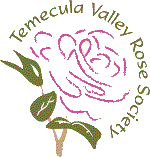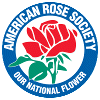Jump to this month's program.
Jump to Frank Brines' FUNdamentals.
Jump to Calendar of Events.
Jump to our Newsletter Writing Guidelines.
All product names, logos, and brands are the property of their respective owners. All company, product and service names used in this newsletter are for identification purposes only. Use of these names, logos, and brands does not imply endorsement.
President's Message
by Virginia Boos

(This was written a few weeks ago, before the COVID-19 pandemic interruption. I'm hoping we can be completely connected again very soon. Members have been sharing rose photos, Rose Haven weeding and care activity, and staying in touch with messages, which are all valuable tools to keep us "connected". My thanks to everyone. Hoping to see you soon.)
Are you "connected" to the Temecula Valley Rose Society? That means being involved with our activities, such as bringing roses to display in the Little Rose Show, sharing your culinary skills with a lunch donation, offering positive (or negative) comments to Board members, telling a story for Rosy Sharings, greeting guests with a welcoming smile, and assisting wherever needed.
A connection gives one a comfortable feeling when attending our monthly meetings, so don't be shy or hesitant. You will definitely have more enjoyment when being part of our gatherings.
April Member Meeting Postponed
by Linda Freeman
The April member meeting is postponed because the Library is closed until April 30. Our speaker was going to be Penny Alderson from Armstrong Garden Center about the new 2020 roses. They are still serving our community by staying open and providing curbside pickup or delivery, and you can contact them at armstronggarden.com or 951-308-9100. We will update the membership when meetings can start again.
Let us all see what you have blooming in your gardens and at Rose Haven and share tips by emailing to Linda Freeman at lee.linda@verizon.net so we can share and have a virtual garden tour this Spring. Also Visit us on Facebook for roses from around the world as well as local rose information.
April Rosey Ramblings from Members
by Linda Freeman
As we are all social distance we are instead embracing our gardens and our members are sharing garden tips. Don Nordike offered some kitchen to garden repurposing tips that he incorporates into his rose garden. Don advises that aphids can appear overnight right now and that daily garden inspections are important.
Don uses kitchen dish soap and water in a sprayer to dispatch the aphids. Also if you have not fertilized, there is still time to add Epsom salts and rose fertilizer which must be totally watered in. Don adds that the Epsom salts, in addition to spurring growth, can make rose flower colors brighter and darker.
Also, used tea leaves and tea bags can be repurposed by placing them around the rose plant and watering them in for a second use to nourish roses. Don recommends saving your banana peels! Dig a hole alongside the rose and place your banana peels in it and cover with soil and water, and the decomposing banana peels will nourish your roses. Don will be happy to accept everyone's banana peels!
A final tip is to visit your local coffee house/Starbucks around 3 p.m. to 5 p.m. and get extra coffee grounds from them to add to your soil. Don's upcoming garden maintenance will be mulching which he plans to start to early April.
May Olson uses any fruit, vegetable or other kitchen scraps that are fading by chopping them into fine pieces that can be worked in to the soil and covered and watered in, which then decompose and feed the roses.
Using banana peels and coffee grounds are tips I hear often from our members. Let me know what kitchen-to-garden tips you use for your roses.
My Adventure with 'Dr. Huey'
by Linda Freeman
Thirty years ago when my husband and I moved to Canyon Lake we were commuting to Orange County but we knew we wanted some type of garden on the 1/3 acre blank lot we had purchased, so we did what most commuters do – we installed grass and trees and an overhead sprinkler system, all for easy care by a gardening service.
We did have a 30 foot vegetable garden where we grew artichokes, tomatoes, lemon cucumbers, corn, asparagus and other fun things, and we worked on it in the evenings after we got back from Orange County.
We also decided on some color, so we installed 30 roses along a 50 foot chain link fence that separated us from 5 acres of vacant land (where the ground squirrels and gophers lived planning their attacks).
The site was not optimal for roses, and gophers were eating all the roots, and we decided that vegetable gardening really did work well for commuters, so we tore out the vegetable garden and transplanted the roses to the former vegetable garden. We planted Pyracantha along the fence line and some Bougainvillea for screening.
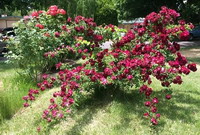
Suddenly, a very leggy red rose started to pop up right around where all the rose bushes had been. It had a very open petal arrangement and we intertwined it with the chain link fence and it blended in with the red bougainvillea, and grew vigorously and we really enjoyed it. I had met Dr. Huey and did not know it. It grew for the next 30 years along that fence line.
After I joined the Rose Society around 2015-2016, I started to learn about the different root stocks and then I connected the dots to my friend Dr. Huey. My roses got a third transplant when we decided to put in a pool and many did not survive, but Dr. Huey is still growing at my former home according to the new owners, and still resisting the assault by the gophers and ground squirrels!
A Wild Rambler from 'The Backyard Gardener'
by Dustin Blakely
It's rose season in the Owens Valley. Every yard in my neighborhood is full of blooms. Among all the cheery white, pink, yellow and red blossoms atop nice straight stems you can often find our most common cultivar of rose, 'Dr. Huey', arching its long, weedy neck up and then back toward the ground with a heavy load of dark red blooms. Although it was released in 1920, few gardeners deliberately plant 'Dr. Huey' roses. It's a vigorous rambler that only flowers once, usually in May for us.
So how did it get here? As you can see from the picture 'Dr. Huey' is a VERY VIGOROUS rose. (That is one year's growth!) For that reason it was – and still is – commonly used as a rootstock to graft other roses onto. That beautiful 'Veterans Honor' rose you bought is probably grafted onto it. Its strong vigor makes it a good choice to help rose scions grow well, but it does have a tendency to, well, escape.
It's not uncommon to find suckers emerging at the base of a rose bush. These suckers will usually be very glossy and the leaves will look a little different than the rest of the plant. That's 'Dr. Huey' trying to escape. When you see these suckers, do your best to prune them off. If they are left to grow, they will eventually take over as the dominant shoots of the plant and will starve out the desirable cultivar grafted onto it. This is how we have so many 'Dr. Huey' roses in our yards.
Of course, you may just decide to keep it. It does have a graceful arching form and a real will to live. It's a hard plant to kill – even on purpose! Since it only blooms once a year, it is best to prune it after it flowers. Don't be gentle with pruning it. Neglect will lead to a giant, thorny mess.
'Dr. Huey' is not very prone to problems, which is good and bad, I suppose. It doesn't have issues with aphids as severely as more desirable roses, but it still gets them. Usually control is not necessary. The most common malady is powdery mildew. Again, probably not worth worrying about since it is not fatal.
It may not be the best of all roses, but, to its credit, it is a rose anyone can grow. And you probably already have it!
Grocery Cards Benefit Rose Society

Dear Members: I trust that you have made a determined effort to use Stater Bros. Scrip/Gift Cards for your everyday normal purchases. Even in these financially difficult times we all must eat. Purchasing a $100 Scrip Card will let you spend $100 for groceries at Stater Bros.
There is no extra expense or donation coming out of your pocket and the Rose Society will get a $6.00 donation for the upkeep of the Garden. Your support is greatly appreciated. Email Ann Coakes to order Scrip Cards, or phone (951) 693‑5635.
This Month's Program
Because of the COVID-19 pandemic there will NOT be an April meeting at the library. Thank you for your understanding. Stay home and stay safe.
Date:
Time:
Place:
Topic:
Speaker:
Birthdays and New Members
| Birthdays | New Members |
|---|
|
Susan Howell, Mar.15; Agnes Felipe, Mar. 22; Michael Momeni, Mar. 22
|
♦ There are no new members this month.
|
Rose Haven Garden
by Bonnie Bell

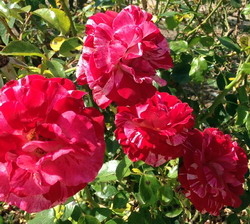
Spring has arrived in the garden, we've been anxiously waiting for it through the rainy winter months. Soon the rose buds will burst into beautiful spring bloom. A brilliant one is Rock & Roll, a Grandiflora with a delightful fruity fragrance, shining its full red and ivory colors on long stems great for cutting. It was hybridized by Tom Carruth for Weeks Roses in 2009.
Rock & Roll was a favorite among the invited visitors from the Garden Club who were allowed to take cuttings. Using proper techniques we hope the cuttings will grow into beautiful rose shrubs. To locate Rock & Roll at the garden look about five feet in front of the tool shed.
See the Rose Haven Garden web page here. Click
here to see the Google map to Rose Haven Garden.
Welcome to the Hall of Fame's "new look"
by Carol Gagliardi
There was "then" – in Spring 2006 when Rebecca Weersing and Bonnie Bell broke ground for the 'Hall of Fame' section of the Rose Haven Heritage Garden.
There is "now" – when in 2020 a rehab project commenced to include all 'Hall of Fame' roses that were inducted into the World Federation of Rose Societies Hall of Fame between 1976 and 2018. Peter and Carol Gagliardi are spearheading this project, with the assistance of other Rose Society members.
Stop by the Garden and see the progress: A a new trellis that will support climbing roses, and the planting of 30 new rose plants.
Between "then" and "now", there have been changes in caretakers of the 'Hall of Fame' section, changes in design of the section, etc. Stay turned for a complete story of the 'Hall of Fame' in a future article.
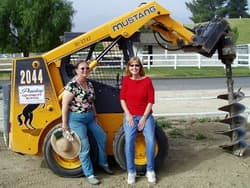
Rebecca and Bonnie |
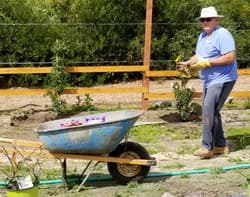
Peter Working in the 'Hall of Fame' |
Families in the Garden
by Alicia Cline
A "Hello" to all our families in the garden. In keeping with the quarantine protocols and procedures, our program has been placed on hold until further notice.
With having everyone's movements so restricted right now, we thought we should pass along a few website links to view birds from webcams. We are hoping this can give our parents another project for the children to view, and a reminder that life does go on. We will weather this storm, as we do all the storms of our gardens.
• At Big Bear: Watch "Big Bear Bald Eagle Cam": Click here.
• At Cornell University: Live Royal Albatross Cam - #RoyalCam - New Zealand Dept. of Conservation | Cornell Lab: Click here.
• Watch Live Barred Owls! Wild Birds Unlimited Barred Owl Cam | Cornell Lab: Click here.
When you log on to these sites you'll see additional links to other webcams available around the country. Please enjoy them and stay safe. We will see you just as soon as we can.
Rose Haven Trees
by Rebecca Weersing
There are two deciduous trees in our Urban Forest garden area, on the righthand side as you go up towards the backside of the gazebo. I took a photo so I could share the photo and information about the trees for our April newsletter. By the time I was sitting in front of my computer, I couldn't remember whether there was one tree or two but I was totally convinced that the tree I had photographed was the tree that always looked dead going into summer.
I was so excited to share that for some unknown reason this nearly dead tree was leafing out in late March! Since I was working on my article two days before the deadline (instead of two hours before the deadline under normal conditions) I decided to check my facts by going back to the garden.
I walked into the garden and immediately saw two dead-looking trees stubbornly holding onto leaves from last fall. My first thought was "How can this be? The trees I saw had no dead leaves and were sprouting new ones!" Shaking my head, I proceeded farther into the Urban Forest and rediscovered the two Ginkgo biloba sprouting new leaves.
I would have been so embarrassed if I had written an article with my false memories! (I do promise to write an article about the trees that look very dead right now but I am certain at some point will have new leaves.) My new motto for writing articles is taken from the old adage "Measure twice, cut once" to "Fact-check twice, write once".
For more information about visit this website to read more about the Ginkgo biloba.
The Ginkgo tree is a living fossil, with the earliest leaf fossils dating from 270 million years ago. It was rediscovered in 1691 in China and was brought to this country in the late 1700s. The seeds and leaves have been (and are still today) used in medicine throughout the world.
"Hailed as 'undoubtedly one of the most distinct and beautiful of all deciduous trees,' the ginkgo certainly stands out. Unique, fan-shaped leaves turn a stunning yellow color in the fall. It can tolerate many urban conditions including heat, air pollution, salt, and confined spaces. And it establishes easily."
To read this interview with Botanist Peter Crane about "The Life Story of the Oldest Tree on Earth" click here. When you are at the Rose Haven, stop by and visit our lovely trees.
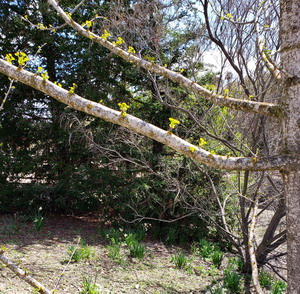
Ginko Spring Growth
Photo by Rebecca Weersing |

Ginko Plate Design
Photo by Rebecca Weersing |
How Does Our Garden Grow?
by Rebecca Weersing
The challenge to our committees and Board of Directors during the next month or so is determining how to conduct business by keeping social distance without being in the same room. The Board was able to defer its business until its next meeting but the Fundraising Committee and the Rose Haven Committee need to meet regularly as there are physical projects to be managed and monies to be raised.
To meet this challenge here is how we have evolved in just a few short weeks: The fundraising committee, consisting of five members, had its first meeting on March 11 at a local Starbucks. Our next meeting was scheduled for March 18, but by that time social distancing was being promoted and non-essential gatherings were being discouraged. The fundraising committee decided to try a phone meeting, which went well, and at the end of the meeting we discussed the upcoming meeting of the Rose Haven Committee which has 18 committee members.
We postponed the March 25 meeting to April 1. The Fundraising Committee met by a different teleconferencing system on March 25. In anticipating the larger numbers of participants for the Rose Haven meeting, we have created a one‑page agenda with nearly 45 pages of backup material.
A particular person has been designated as the lead on each agenda item. It is important when conducting this type of meeting to prepare ahead of time and to keep the meeting moving along so that all agenda items are covered in an efficient manner.
Meetings can be handled by phone but the real work of pulling weeds, deadheading, building a trellis, planting a rose still requires being physically at the garden. While in the garden we are maintaining social distancing, spreading out so that no gathering is greater than 10 people, and enjoying nature. Happily, those of us who have been to the garden can report that our roses have started to bloom and before long there will be blooms all over the garden.
Temecula Valley Garden Club
Click here for their upcoming monthly meeting news.
Their Facebook page is here.
Some April Garden Tips
Riverside Master Gardeners
Rose Care FUNdamentals
by Frank Brines, Master Consulting Rosarian
All photos by Frank Brines

These past couple of weeks most areas have gotten above average rainfall. While it is welcome, it presents problems for gardeners when it arrives over such a short period of time. The "good" is that one doesn't have to pay for city water that contains more salt, and the rains leech salts out of the soil (some from fertilizers). Rain also replenishes the natural aquifers and lakes.
But so much moisture creates an environment for fungi, especially powdery mildew, rust and botrytis. Many roses have serious botrytis fungus this year (shown below). It is the result of too much moisture trapped in the blossom. There doesn't seem to be any treatment beside removing the infected blossoms.

Botrytis fungus |

Botrytis fungus |
So far, I have been able to minimize the powdery mildew (shown below) and rust with scheduled spraying. There are many treatments available at your local garden store. Read labels, compare information to select that which fits your use best.
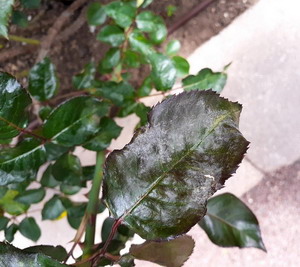
Powdery Mildew |
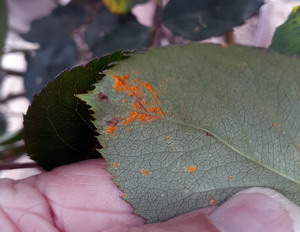
Rust spores |
Rust (above right) appears on the underside of leaves and, like its name, looks like rust. It is actually an eruption of tiny spores that group together and can kill a plant if not controlled. When it becomes overwhelming it is best to just remove all of the infected leaves and discard them in your green waste.
Like all rose debris, never let it remain in your garden or yard – spores that accumulate on the soil may be quickly splashed up onto the lower leaves by water and then can spread onto more leaves and plants. Proper pruning that provides good air circulation through the bushe should help to prevent mildew and rust by minimizing moist conditions within the bush.
Currently the Hoplia Beetle is damaging blossoms, most notably on light colored blooms. They burrow into the petals but are easily controlled by flicking them off into soapy water. My first experience with the Hoplia Beetle was 2019 when I removed nearly 100 from my garden. Their appearance doesn't seem to be influenced by temperature except that they hibernate in the soil after mating.
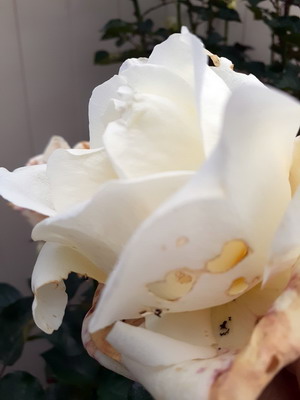
Hoplia beetle |
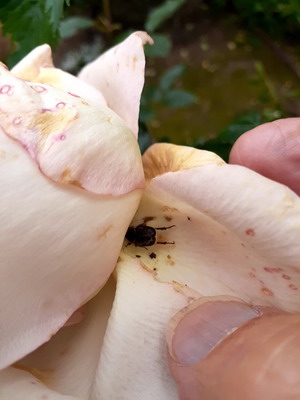
Hoplia beetle |
Roses love food and water. Larger blossoms are produced when well hydrated, and the rain has helped to accomplish that. I maintain a well‑balanced soil by providing minerals and micro nutrients every two weeks. I use the wet/dry method, that is, I apply a mix of nutrients/fertilizers dissolved in water for one application, and then two weeks later I apply a dry mix. I'm always very careful to keep the concentrations at recommended levels to prevent burning.
Make sure your roses are well hydrated before feeding. Never fertilize a dry plant! I admit that the wet weather has made wet/dry fertilizing problematic: so much rain makes the wet method impractical as the typical garden bed is already saturated. When that's the case, I substitute a dry mix for the wet one until the soil is no longer saturated.
For more ideas, visit TVRS' Rose Haven Heritage Garden. Click here to see the map to Rose Haven Garden in Temecula, as well as our Society web site at Temecula Valley Rose Society.org. Spread the joy of roses!

